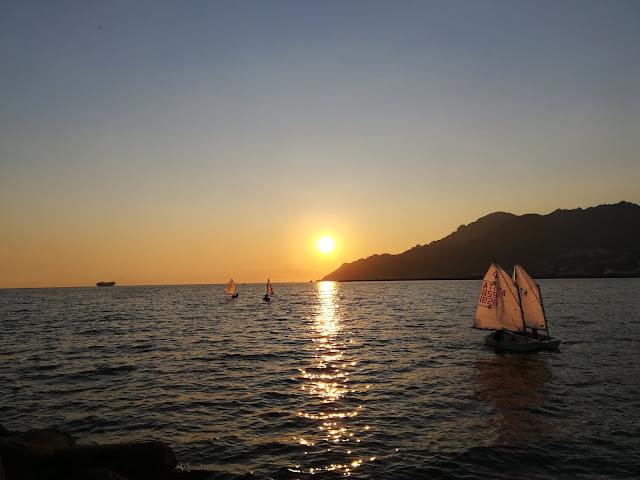After moving to Rome for work in mid-November, I took the chance on my first weekend to take a day trip to the small town of Orte less than an hour north by train. After arriving at Orte's train station which is located a few kilometers from the city, I had to walk uphill to reach the city center. After nearly an hour I reached the old town, characterized by the typical medieval houses built on top of a high tuff cliff, present in many other cities of the area. I first encountered the church of Sant'Agostino, which was unfortunately closed, and then the church of San Silvestro, also closed, which holds the museum of the diocese. A little further I then arrived in the central square, Piazza Della Libertà, with the nice town hall crowned by the clock tower on one side and the Co-cathedral of Santa Maria Assunta on the other. Built on top of a previous medieval one, it was reconstructed during the 18th century in a mix of Baroque and Rococò styles. The interior is quite empty and unimpressive but features a nice airy cupola. As I walked further I then reached another church, that of San Francesco, also unfortunately closed, but I was able to at least admire the nice medieval cloister set next to it. As I continued through the city center, I reached some nice panoramic points from where I could admire the surrounding landscape. Despite the gloomy weather, the view was nice, particularly from the northern ramparts as I was able to see the Tiber river just below me. As I reached the western end of town, where the castle, now just a renaissance palace, used to stand, I had another great view this time of the countryside to the south of the city. The walls of the city were quite visible from this side, as they were probably built higher and stronger than the other side once protected by the river itself. As I completed my round around town, I finally headed to the tourist info point where I bought my ticket to see the city's main attraction: the underground city. Orte is in fact famous, like other places around the area, for its rich and vast amount of tunnels, caves, rooms, and structures which lay right below the houses. The entrance was through a guided tour with a few other tourists, all coming from the surrounding areas. The guide was in fact quite surprised I came from the north of Italy. The tour began right below the main square, where an underground fountain is set dating most probably to ancient roman times. Orte in fact boasts a continuity of life from the end of the Bronze Age to today's times. Inside the cliff on which the city is built upon, during almost 2500 years of uninterrupted life, the water supply network (tunnels, cisterns, wells) and wastewater drainage, warehouses, storerooms, cellars, stables, dovecotes, some living quarters, craft workshops and fountains have been created. This particular fountain is the main one receiving water from the aqueduct that dates to the 4th century B.C., so during the Etruscan period. As we circled the fountain, we passed through a tiny gate and entered the tunnels proper, dating both to the Etruscan and Roman periods. The guide showed us the difference between an Etruscan and Roman one, the former having conical shaped holes in the ceiling and the latter having ones shaped like roof tiles. As we meandered through the complex tunnel system the guide explained the history and use of each of the parts. The system was extensively used until nowadays, with a hospital even being set up which operated well until the end of world war II, when the population took refuge underground to escape the bombings which targeted the nearby train station. Nowadays the site is an important tourist attraction and some houses and enterprised still use part of it as their garage/cellar. Particularly noteworthy were the dovecotes found on the northern slope, towards the Tiber river, where pigeons and doves were held during the medieval times as a system to communicate with the outside and as a food supply. They were very similar to those I had previously seen in the underground system of the city of Orvieto, not far from there. Once the tour was over we popped out in the street near the castle, where our guide thanked us and waved goodbye. From there I decided to walk through the center and exit by the same street I had come in through. I headed downhill and then took a little deviation to the nearby hill where the Santuario della Santissima Trinità is located. Built on the side of the hill, partly inside the rock, this little sanctuary dates to the 14th and 15th centuries and features a nice little interior with a fresco dating to 1460. From the terrace, in front of it I was able to admire the old town of Orte on the hill right in front of it. It was then time for me to head back to the train station from where I was able to take the next ride back to Rome.
 |
| View of the houses built on the high tuff cliff |
 |
| A street in the old town |
 |
| The church of San Silvestro |
 |
| The main square, Piazza Della Libertà, with the town hall |
 |
| Another street in the old town |
 |
| A terrace with a view and an old cart |
 |
| View of the town and the tuff cliff |
 |
| One of the Etruscan tunnels of the underground city |
 |
| View of the river Tiber |
 |
| The dovecotes in the underground city |
 |
| An old house in the old town |
 |
| View of Orte |



















































